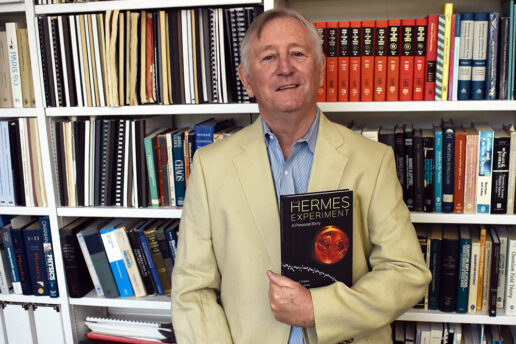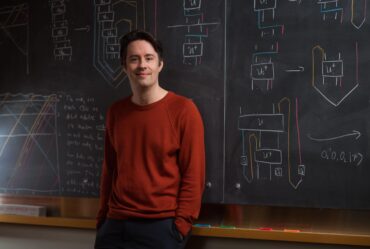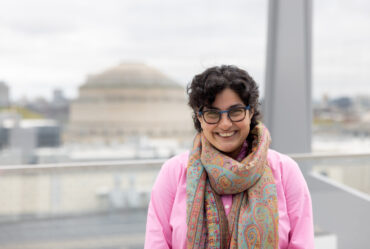
3 Questions: Richard Milner on the messier side of physics
Physics professor’s new book looks at the international collaboration behind HERMES, an experiment studying the spin structure of matter.
“The Hermes Experiment,” a new book by MIT physics Professor Richard Milner and FAU Erlangen-Nurnberg Professor Erhard Steffens, tells the story of how several hundred physicists from Europe and North America collaborated in 1988 to design, construct, and operate the innovative HERMES experiment at the DESY laboratory in Hamburg, Germany, with the goal of studying the fundamental spin structure of matter. The book serves as a primer on subatomic physics and provides a personal look into how physics gets done, from how scientists secure funding and build teams to what it takes to construct a large experiment and compile the results.
HERMES, in operation from 1995 to 2007, pioneered the use of polarized internal gas targets, which were subsequently used to great effect at the MIT-Bates South Hall Ring at lower energies for the BLAST experiment. The ability to experimentally realize pure electron-polarized target scattering was an important technical achievement that influenced such projects as the Electron-Ion Collider and other important research.
HERMES also provided education and training for several new generations of physicists on both sides of the Atlantic, including many at MIT. Milner and Robert Redwine led the Hadronic Physics Group’s efforts. Jeff Martin PhD ’00 is now on the faculty of the University of Winnipeg, leading Canada’s search for a non-zero neutron electric dipole moment. Bryan Tipton PhD ’99 is now a research scientist at MIT’s Lincoln Laboratory. Naomi Makins ’94, now a professor of physics at the University of Illinois Urbana-Champaign, played a leading role in the analysis of the HERMES data, and her own students on HERMES are now leaders in the field of nuclear physics. Wolfgang Wander earned his PhD at the University of Erlangen on the track reconstruction for HERMES, later led the MIT Laboratory for Nuclear Science Computer Group, and is now a leading data scientist at the hedge fund Renaissance Technologies. Here, Milner describes the book and his goals for adding to the history of science.
Q: Who is the intended audience for your book?
A: It’s a different kind of book. We teach physics as a very logical subject, but that’s not how research at the frontiers gets figured out. It’s messy, often does not follow a linear path, and there are people involved. The personal story of our participation in the HERMES experiment forms the central narrative of the book. By telling a human story, we intend to attract a broader readership beyond physics. Our book is written without mathematical equations or symbols principally to share with the curious reader without a technical background how a large experiment like HERMES comes about. Thus, we have two introductory chapters that explain the current understanding by physicists of the laws and structure of the subatomic world. In addition, we have appendices that explain scientific notation as well as commonly used acronyms. However, we also expect the readership to include interested physicists, particularly those who have worked on the HERMES experiment or related research. We have made a particular effort to identify the main contributors over several decades, particularly the large number of young physicists who worked on the experiment and are now leaders in physics around the world.
Q: How did you and Erhard Steffens arrive at the decision to write “The HERMES Experiment”?
A: It was not our idea! I was approached by an editor for World Scientific in 2016 who had been advised by somebody unknown to me that a book on the HERMES experiment, written as a personal story, would be of broad interest. After considering it, I realized that to produce a book of value, it was essential to have a co-author from the German perspective. Fortunately, Erhard and I had worked closely together on the HERMES experiment, continued to collaborate as successive chairs of the International Spin Physics Committee, and we quickly agreed to co-author the book together.
The conception and realization of HERMES were carried out in a way that was quite different to how such experiments typically develop. In addition, the DESY laboratory in Hamburg, Germany was open to a group of nuclear physicists using their new HERA collider accelerator in a novel, unanticipated way. We both had been impressed with the technical success and the scientific impact of HERMES, and felt that devoting the necessary multiyear effort to writing down our personal story about the experiment, which was a major aspect of both our careers, had the potential to produce a book that would be unique. Further, if written well, we believed that it could attract readership well beyond the HERMES research community. In September 2016, the editorial board of World Scientific approved our book proposal.
Erhard and I were fortunate that we spent a week together at his home in Bavaria in January 2020, where we shaped the final outline of the book. Within weeks, the pandemic hit, and we have not met in person since then. However, over the year of the pandemic, we focused on finalizing the book through very regular calls, and it was completed in March 2021. The book is one positive outcome of the pandemic!
Q: What were the impacts of your research when it began in 1987, when you finished in 2007, and today?
A: In 1987, the proton was typically portrayed as a round billiard ball where the structure was dominated by non-relativistic quarks. In 1988, one of the co-discoverers of quarks, Jerry Friedman, was the MIT physics department head, and he hired me to the MIT faculty. The position was related to the construction of the new South Hall Ring at the Bates Accelerator Center. The scientific motivation was to utilize polarized internal gas targets, which were then still largely in development. Their potential had been recognized by Ernie Moniz, Stanley Kowalski, Bob Redwine, Bill Donnelly, and others. In the development of the HERMES experiment, we received important guidance from MIT theorists Bob Jaffe and Xiangdong Ji (formerly at MIT, currently at the University of Maryland).
By 2007, when HERMES was completed, polarized internal gas targets were a mature technology with programs also completed at Bates and at the Indiana University Cyclotron Facility in the U.S. and at Amsterdam, Juelich and Heidelberg in Europe. Bates engineers Jim Kelsey and Ernie Ihloff played a central role in the technical realization. Scientifically, HERMES had opened up new avenues of research by detecting pions in coincidence with the scattered electron. There had been a revolution in that the proton was now viewed as a highly relativistic system of bound, interacting quarks and gluons. The interactions produced virtual quarks and gluons which could only be accessed experimentally at high energies.
Fourteen years later, there is an exciting new multibillion-dollar facility called the Electron-Ion Collider (EIC) being planned to continue the study of the fundamental quark and gluon structure of matter. It will be realized around the existing Relativistic Heavy Ion Collider at Brookhaven National Laboratory on Long Island in New York, and is expected to begin operation in the early 2030s. It builds on the pioneering work of HERMES, other experiments, and theorists. I think of EIC as HERMES at higher energy, but realized in a way where the complete final state of the smashed proton or nucleus can be measured. There are seven MIT physics faculty working on a proposal for an EIC detector called ECCE involving more than 75 institutions from around the world, and Or Hen is one of the leaders. In the Center for Theoretical Physics, we also have a world-leading theoretical effort in QCD [quantum chromodynamics], which includes Frank Wilczek, one of the fathers of the theory. In addition, we have a first-rate group that carries out ab initio QCD calculations using simulations on the world’s largest supercomputers. In the end, understanding QCD will require the best efforts of experiment, theory, and lattice calculation.
It is remarkable that the HERMES collaboration is still active and is producing important science over three decades after it was initiated!


